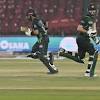LaMelo Ball and Victor Wembanyama Are Pioneering This NBA Shot

Throughout the 2024-25 NBA season, fans and media members have bemoaned another spike in 3-point attempts. Old heads proclaim that there’s no creativity in the game anymore.
Yet not all 3s are the same. A new approach is adding a subcategory to the deep ball while countering the notion that imagination is dying out in the NBA.
The development showed up last weekend in the finals of the 2025 NBA All-Star Game tournament, when Steph Curry drove left around his defender and launched a 3-pointer from the top of the key off one leg like he was shooting a floater in the paint. Swish. It was a classic example of the showmanship for which fans have historically tuned into the All-Star Game—to see the best players in the world try cool plays that they might not in a real game.
This season, however, the one-legged 3 has become a shot that players do use in real games. LeBron James has taken six 3-pointers off of one leg and made four of them. San Antonio Spurs 7-foot-3 phenom Victor Wembanyama has taken seven one-legged 3s, converting on three tries. The shot isn’t just reserved for stars, either—last month, Memphis Grizzlies rookie and second-round draft pick Jaylen Wells hit one over the towering Wembanyama.
The one-legged 3 was not invented this season—Curry actually made one in a game all the way back in 2013. Since then, players from Klay Thompson to Pero Antić have used it as a one-off, but not regularly. In the 2019 offseason, former MVP James Harden showcased a new one-legged 3-pointer move in summer workouts and even broke it out in the preseason, but never added it as a staple in his repertoire. The one-legged 3 was purely a heat check shot, such as when Kevin Durant unleashed it against the Atlanta Hawks as part of a 55-point outburst.
Now, it’s a reliable offensive weapon for some players. “KD had done it against us a couple years ago and so I saw how it worked for him,” said Atlanta Hawks guard Trae Young, who has already taken 15 one-legged 3s this season after attempting just one prior to the All-Star break last season.
“I started taking that shot because I didn’t want to get my shot blocked when I came off a screen,” the 6-foot-1 Young said. “Obviously I’m smaller, but I have the tallest and longest-armed defenders on me every game. A couple guys, guys like Jaden McDaniels, blocked my shot one or two times too much and I was like ‘I’m gonna start this one-legged 3.’”
Last season, in a Jan. 12 game against the Indiana Pacers, Young came off a screen dribbling to his left, stopped on two feet and had his shot blocked by 6-foot-1 T.J. McConnell from behind. About 0.75 seconds elapsed between his pickup and his release. In a similar situation on April 12 against the Minnesota Timberwolves, Young opted for the one-legged 3, releasing the ball approximately 0.5 seconds after gathering, before the leaping defender could reach it. For a short player often giving up six inches to his opponent, that quarter of a second makes a big difference.
As one of the NBA’s tallest players, Wembanyama’s motivation for using the shot isn’t a concern of getting blocked, but rather how it feels. “It’s actually easier to shoot 3s that way, I believe, because you use your momentum, so you don’t have to use any force and you can really focus on the target,” Wembanyama said in 2023 on The Young Man and the Three podcast.
“A couple years back I was training with Tim Martin, my coach, and I was doing reps of this, and he was laughing, because it’s just funny to see someone practice this, but it just feels natural to me. And it’s surprising to the defender… even for regular-sized players, you can’t really defend that.”
LaMelo Ball is arguably the NBA’s master of the one-legged three. An analysis by Todd Whitehead in January using Sportradar player-tracking data revealed that Ball had attempted 53 such shots this year with a difference in ankle height of at least six inches at the time of release. That number may be an overestimate of true one-legged threes, since Ball has a natural habit of raising his right foot even when he pushes off two feet, but Sportico hand-counted 30 of Ball’s 407 3-point attempts this season that he shot after clearly generating lift from just one leg. He tried only eight such shots last year.
Ball’s one-legged 3s typically have less in common with Young’s 3-point floaters and more with Dirk Nowitzki’s patented mid-range fadeaway. After dazzling with Globetrotter-esque dribble moves and falling away from the hoop, Ball can balance himself more easily by pushing off his left leg and elevating his right leg than he would by trying to get both feet squared under him. For a shooter with a relatively low release point, the raised leg also serves as a convenient barrier between him and his defender. Per Sportradar, Ball has made 40% of his one-legged 3s, better than his overall 34% 3-point percentage on the season.
NBA teams are taking 42% of their shots from behind the arc this season, the highest frequency in league history, after that rate steadily increased throughout the 2010s. Much of that strategic shift is at the team level—coaches are giving more minutes to stretch big men who shoot rather than post up, role players are now stationed in the corners instead of closer to the basket and stars are encouraged to pull up from downtown rather than from the mid-range.
Some of the 3-point surge, though, has been driven by individual players simply developing new ways to take shots from beyond the arc. Harden innovated by implementing the step-back 3-pointer as a key element of his bag, and other players followed his lead. That move mutated into the side-step 3 that many stars now shoot as well. Catch-and-shoot specialists have mastered the “no-dip 3,” where they start their shooting motion before the ball even arrives, allowing them to catch and release the ball without wasting time by bringing it down.
The one-legged 3 is just the next step of this evolution of shot-making techniques, and it certainly won’t be the last.


 Canada
Canada Argentina
Argentina  Australia
Australia  Austria
Austria  Brazil
Brazil  Chile
Chile  Czechia
Czechia  France
France  Germany
Germany  Greece
Greece  Italy
Italy  Mexico
Mexico  New Zealand
New Zealand  Nigeria
Nigeria  Norway
Norway  Poland
Poland  Portugal
Portugal  Sweden
Sweden  Switzerland
Switzerland  United Kingdom
United Kingdom  United States
United States 





























